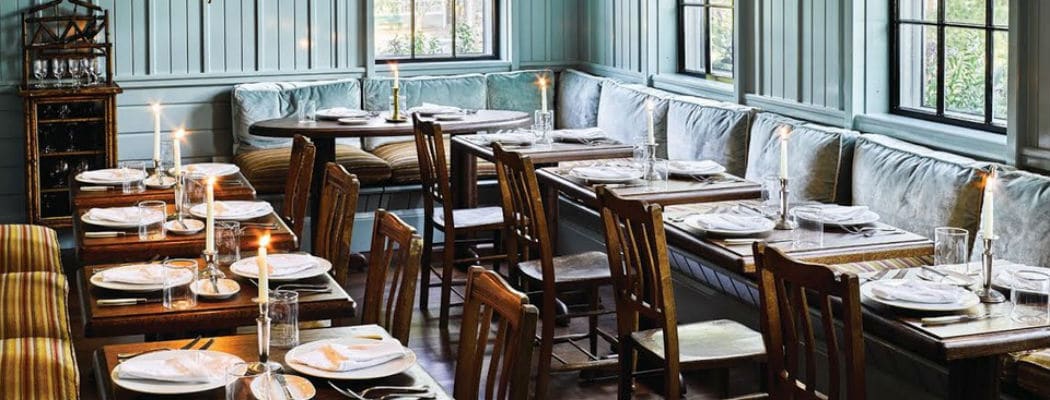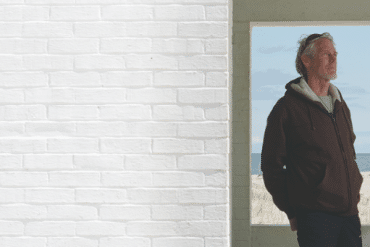Hollywood brought Robin Standefer and Stephen Alesch together. As production designers and art directors, they collaborated on designing more than twenty film sets, working for the likes of Martin Scorsese. Their first residential design project came courtesy of Nantucket summer resident Ben Stiller, whom they worked with on a film. After designing Stiller’s home in Los Angeles, Standefer and Alesch founded Roman & Williams Buildings and Interiors, which has since become one the most sought-after firms in the country. Most recently, they were hired to design the Greydon House hotel on Nantucket. Returning to the island next month as keynote speakers at the NHA’s Nantucket by Design fundraiser, Standefer and Alesch gave N a look at their work on-island and off.
 N MAGAZINE: How would you describe your design style?
N MAGAZINE: How would you describe your design style?
ROMAN & WILLIAMS: For us, design is more synonymous with an approach than style. Style implies boundaries, and we find the term to be limiting. Rather than approaching projects from a “designed” perspective, we tease out the story of a space and let that shape our design for each project. This method helps to guide all of our design decisions in a natural and organic way and allows you to make choices from a more instinctive place. In every project we take on, there’s a narrative that we explore and let unfold. We are highly attentive to the people, the experience, and its broader context that we envision in each space we create.
N MAGAZINE: Tell us about your experience designing Greydon House.
ROMAN & WILLIAMS: Nantucket has a rich history of adventure, industry, and seafaring, and we wanted to honor that heritage from a different perspective. The original structure was built in 1850, so there was a deep-rooted story that was very important for us to honor and resurrect. We imagined the sorts of treasures the captains and shipmen would have brought back from their journeys out at sea, and used the locations and cultures that they might have visited to influence our design. For example, in the lobby, chairs from Africa sit next to French stools, and a mural depicting a Chinese merchant port graces the wall behind the bar. The end result is that each space feels unique, as though you’re visiting someone’s home rather than a hotel.
N MAGAZINE: What is one design element that can change the feeling of a room instantly?
ROMAN & WILLIAMS: We love to paint the floor or ceiling a dark or unexpected color. It’s a fairly basic change to implement but can make an enormous difference in the feel of a room. A black floor in an otherwise neutral space creates interest before you’ve even brought in any decorative elements.
 N MAGAZINE: How is designing an interior for an “island location” different than other projects you’ve worked on?
N MAGAZINE: How is designing an interior for an “island location” different than other projects you’ve worked on?
ROMAN & WILLIAMS: Nantucket was an ideal location for us to work on, because the history of the island gave the project a romantic depth. We were able to design in a warm and elegant way while embracing the aesthetic that is unique to the area, being mindful of Nantucket’s tradition, while bringing along our own eclecticisms and nuance. We enjoyed the unique experience of designing for an island vacation surrounding that isn’t necessarily tropical.
N MAGAZINE: How do you successfully incorporate old and new into a cohesive design?
ROMAN & WILLIAMS: We utilize vintage or found elements for many of our projects and layer them in with new items, which we’ve often custom designed. The trick is to not let one overpower the other and to let the elements complement each other. For example, the Greydon House exterior started with an original structure that we expanded upon with new construction. For us, it was of the utmost importance that we kept the new design true to the roots of both the original building style and true to the roots of the style of the island. Spaces that are successful are places that feel authentic. The “old” or original style should blend harmoniously with the new elements.
N MAGAZINE: What role does history play in design in the twenty-first century?
ROMAN & WILLIAMS: We believe that the current and future state of design is respectful of history and tradition. Today, the public is very educated about what is fake and patronizing, as opposed to real and sincere. The role of the designer is to build something sustainable, something with longevity. People are loyal to things that feel authentic, things that they can connect to. The more unselfconscious you can be in your designs, people will feel that in the final product.
 N MAGAZINE: Which designers have most impacted your career?
N MAGAZINE: Which designers have most impacted your career?
ROMAN & WILLIAMS: We’ve been highly influenced by French and English eighteenth and nineteenth century country homes, both the houses as well as their landscapes. Gertrude Jekyll’s work as a horticulturist and garden designer is an inspiration in both our professional and personal lives. On the architecture side, Bernard Maybeck, who was influential in the Arts and Crafts Movement, H.P. Berlage who was considered the “father of modern architecture” in the Netherlands, and Eliel Saarinen, an architect known for his Art Nouveau work, are all reference points for our own work. Our love for beautiful objects has always been the guiding force behind our designs. In line with our work with the Metropolitan Museum of Art, we’ve recently been inspired by Christopher Dresser’s work in the decorative arts. He was influential in the Design Reform Movement and Japonism.
N MAGAZINE: What advice would you give to an aspiring designer?
ROMAN & WILLIAMS: Be brave, trust yourself, and question what might be baseline assumptions from your own perspective or external perspectives about what the obvious solution to a problem is. Simultaneously, learn from others who came before you, and don’t be afraid to surpass them. That ambition and competitive sense is productive and motivating.
N MAGAZINE: What are you most proud of in your career?
ROMAN & WILLIAMS: We are extremely proud of the variety of projects that we have had the opportunity to work on. From starting out on film sets to now working on hotels, food markets and museums, this variety has allowed our style and design preferences to constantly evolve and forces us to push past our own boundaries.
Robin Standefer and Stephen Alesch of Roman & Williams will be keynote speakers at the NHA’s Nantucket by Design “Design Luncheon” on August 2nd.






